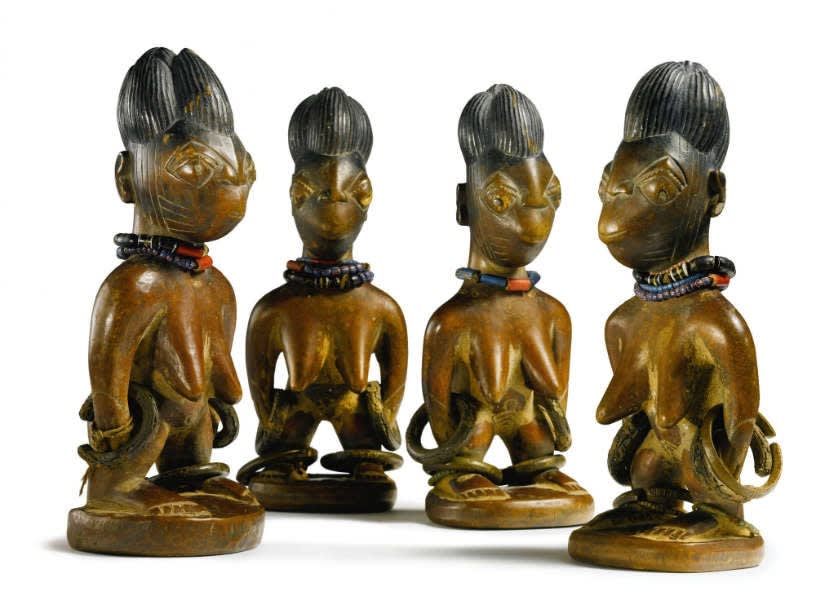
In the Sotheby’s May 16 African, Oceanic and Pre-Columbian Art sale in New York last week four Yoruba female ere ibeji from Nigeria were presented without any contextual information. Nevertheless, this particular style is easily recognizable by its formal characteristics. A short little nose is always positioned high between the lozenge-shaped eyes. From a frontal view, the ears are not visible. They are positioned to the head’s rear and have a quite particular form. The simple hairdo transitions fluently with the face, and consists of different conical volumes. Female ibeji from Baba Magba have low-placed breasts, often reaching down to navel level. The legs stand spread apart, with feet up to the edge of a rounded rectangular base.
According to William Fagg, these ibeji come from Baba-Magba, that he alternately described as a village in the vicinity of Ilorin or as an outer district of the same locality (Christie’s, 13 June 1978, lot 261 & Christie’s, 10 November 1981, lot 186). Equally, Baba Magba was also the title of the chief priest of the Shango cult, who had his seat in Oyo. So it is possible that the name is a commemoration denoting that at one time a Baba Magba came from this village (Fagg in Christie’s, 13 June 1978, lot 261). Fagg identified this style on the basis of an ibeji collected in 1912 in the collection of the World Museum (part of the National Museums) in Liverpool (#22.11.192.167). Stoll & Stoll attribute them to an Igbomina sculptor (Stoll (Gert & Mareidi), Ibeji, Zwillingsfiguren der Yoruba, Munich, 1980: p. 309, #209), and according to Fausto Polo this well-known type of ibeji originates from Offa (Igbomina) (Polo (Fausto) & David (Jean), Ibeji. Catalogue des ibeji, Zürich, 2001:#905).
The master-sculptor who invented this style was active during the last-quarter of the 19th century, something attested to in a female ibeji that was collected between November 1896 and April 1897 by Major-General Sir Cecil Pereira (Christie’s, 13 June 1978, lot 261). This artist was very active and probably established a prolific workshop. Many comparable ibeji in this unique style are known and they were still seen in the field until the 1980s, as shown in this field-photo by Deborah Stokes.

UPDATE: William Fagg revised his attribution of this style a bit in 1984; he now stated this pairs as coming “from south of Ilorin” and gave this specific information: This style is a variant of one of which an example was acquired early in the century by Liverpool Museum, identified as from Baba Magba : this has recently been located as a ward in the town of Ilorin, to which it may be assumed that the style extended. However two years ago ibeji researchers found an old carver of another variant of the style living in a village 30 or 40 miles down the southward road. This variant could well be to the south-east in the direction of Igbomina. (source: Christie’s, London, 10 April 1984. Lot 88. & Christie’s, London, 14 December 1984. Lot 116.)
(Thanks Fausto Polo for the reference!)